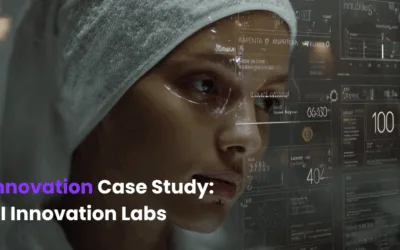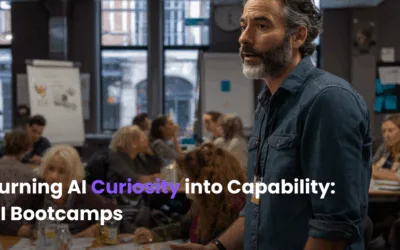Artificial Intelligence (AI) is rapidly transforming industries, evolving from a tool for operational efficiency into a cornerstone of strategic decision-making. Businesses are no longer just using AI to automate tasks – AI is reshaping innovation strategies, transforming how decisions are made at the highest levels.
Research presented at Davos in January 2025 has demonstrated how enterprise leaders are increasingly turning to AI to access real-time data, understand customer behaviour, and drive strategic choices. AI’s ability to analyse vast amounts of information and generate actionable insights is giving companies a competitive edge in what promises to be an unpredictable economic landscape over the next year.
Yet, despite its potential, the adoption of AI remains uneven. In many cases, organisations face a paradox of abundance – so many possibilities, yet uncertainty about where to start when it comes to AI-driven innovation.
In this blog post, I’ll explore how AI is reshaping innovation strategy in a few key enterprise contexts, and look at how the nature of strategy is shifting in an age of AI.
From Efficiency to Blue Ocean Strategy
For much of its early adoption, AI in business was framed as a tool for efficiency; a way to automate processes, reduce costs, and improve productivity. While these benefits remain important, the real transformation is happening at a strategic level. AI is not just helping businesses operate better within their existing models, it is enabling them to redefine what’s possible. This is a shift in strategy away from reactionary responses to market changes, and planning based on historical evidence, towards a forward-looking, opportunity-enabling mindset.
It’s about creating what Kim and Mauborgne described as “Blue Oceans” – brand new competitive landscapes. AI-powered businesses are increasingly adopting Blue Ocean strategies, leveraging real-time data, predictive analytics, and machine learning to develop entirely new value propositions rather than refining existing ones. Instead of competing within traditional boundaries, they are using AI to forecast and even reimagine customer needs, predicting emerging trends, and designing services that have not previously been possible.
This kind of transformation is particularly visible in industries where AI is being used to project ahead rather than react.
- In financial services, AI is shifting banking from a transactional model to a predictive and advisory one, where financial institutions anticipate customer needs before they arise.
- In tourism, AI is enabling dynamic, hyper-personalised experiences, moving beyond standardised offerings to create uniquely tailored services that adapt in real time.
- In healthcare, AI is leading to a shift from reactive treatment to proactive and preventative care, where early diagnosis and predictive models transform patient outcomes.
The biggest strategic change AI brings is in how decisions are made. AI is enabling real-time, continuously evolving intelligence, allowing businesses to shape markets rather than respond to them.
AI as a Driver of Proactive, Customer-Centric Banking
In financial services, business strategy has been characterised by customer transaction analysis, monitoring of credit risk, and adaptation to market fluctuations based on historical data. But AI is now enabling a fundamentally different approach, where banks move from being passive service providers to active financial partners, anticipating customer needs and offering personalised insights in real time.
For example, the Commonwealth Bank of Australia (CBA), is embedding AI into its business customer engagement strategy with its CommBiz Gen AI, an assistant providing real-time, ChatGPT-style financial insights. Rather than waiting for customers to seek out banking advice, CBA’s AI actively guides businesses in financial decision-making, helping them optimise transactions, identify risks, and streamline financial operations.
However, the bigger strategic shift is that AI is not just enhancing customer interactions. Instead it is redefining the role of banks altogether. With AI-driven predictive analytics, financial institutions are moving away from transactional relationships and instead positioning themselves as proactive advisors.
AI as an Engine for Hyper-Personalised Customer Experiences
Tourism and hospitality are industries that have capitalised on standardised, consistent and (most importantly) static service models. It’s been central to many sales strategies that you can rely on your customer experience to be consistent.
But AI is now enabling a shift towards hyper-personalisation, where hotels and travel providers can dynamically tailor offerings in real time, adapting to customer preferences, demand fluctuations, and external factors like market conditions.
Hilton Hotel’s AI-powered concierge, Connie, is an example of AI-driven customer service and revenue management strategies. Connie provides guests with personalised recommendations, learning from interactions to refine and improve its responses over time. Then running underneath the customer engagement activities, Hilton is also running AI-driven revenue management systems, which continuously adjust room rates based on demand trends, competitor pricing, and guest behaviour.
With AI, Hilton is not just managing rooms, it is designing adaptive, real-time guest experiences that respond to individual preferences.
AI as a Catalyst for Predictive and Preventative Healthcare
The same shift from reactive to proactive strategy is being observed in healthcare too.
In 2025, UK’s National Health Service (NHS) launched an AI trial in breast cancer diagnosis. It’s the largest trial of its kind yet undertaken, and it will be analysing thousands of mammograms with AI. The NHS aims to identify cancers earlier and more accurately than human radiologists alone, potentially reducing misdiagnoses and speeding up treatment decisions.
This isn’t just an efficiency gain, it’s a strategic transformation in healthcare. AI is reshaping diagnostic pathways, generating improved patient outcomes through early detection and treatment.
The Future of AI-Driven Innovation Strategy
What these examples of AI-driven strategy demonstrate is a fundamental shift in business strategy. Long term goals don’t entirely shape the way a business operates in this environment. Impact and outcomes are still, of course, relevant. But rather than setting benchmarks, businesses are creating opportunities with the assistance of these AI tools.
The challenge now is not whether to adopt AI, but how to strategically harness it. Businesses that treat AI as a core driver of innovation, not just a support tool, will be the ones shaping the future. It’s just a matter of getting the guardrails for the business in place.
If you need help with your AI-driven innovation strategy, give us a call.



